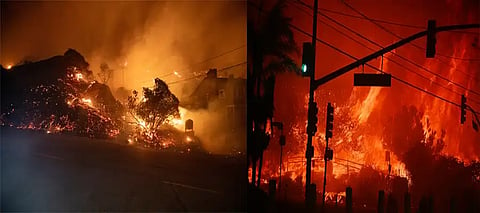

In California, particularly Los Angeles, recent wildfires have surged with alarming intensity, leaving behind charred homes and vast destruction. These fires, which have led to mass evacuations and tragic loss of life, are some of the most severe in the state’s history.
Authorities in Los Angeles have announced a curfew following reports of looting as wildfires continue to devastate the city. The death toll from the fires has risen to 10, with the Los Angeles Country Medical Examiner confirming the increase. All victims’s identities are pending confirmations, and legal next-to-kin notifications are underway.
Meanwhile, strong winds and extensive drought conditions have fueled the fires, exacerbating the damage across the city. In total, 20 people have been arrested in connection with the ongoing crisis.
While wildfires are no stranger to California, several key environmental and scientific factors have combined to exacerbate the situation, making this year’s outbreak particularly devastating.
One of the major contributors to the rapid spread of the fires is the powerful Santa Ana winds. These strong, dry gusts blow from the desert interior of the U.S. to Southern California, dropping humidity levels and creating ideal conditions for fires to spread. Winds above 80 mph, reaching up to 100 mph in some mountainous areas, have significantly fueled the flames. As the dry winds push warm air towards the coats, they dry out vegetation, making it highly flammable and accelerating the spread of fires.
Additionally, the water supply in some areas such as Pacific Palisades, ran dry after extensive firefighters' efforts. Urban water systems are not built to handle wildfires, which left firefighters struggling to contain the blaze once the tanks were depleted.
Another critical factor is the drought that has gripped Southern California. After two winters of heavy rainfall, vegetation grew abundantly. However, this winter, conditions have been usually dry. With much of Southern California experiencing drought, the once-lush vegetation has become tinder-dry, creating the perfect fuel for wildfires. In contrast, Northern California has seen much more rainfall, leading to what climate scientist Daniel Swain calls a “precipitation divide.”
The influence of the climate crisis has made these fires both more frequent and intense. Global warming, driven by the burning of fossil fuels, has resulted in more extreme “fire weather” days periods with a highlighted risk of wildfires due to dry conditions and lower humidity. Scientists have found that climate change has increased the risk of fast-moving fires in California by about 25%. Ten of the largest wildfires in the state’s history have occurred in the last two decades, with five of them happening just in 2020.
The recent fires in Los Angeles are a direct result of this compounded crisis. Human-caused climate change has contributed to a 172% increase in burned areas in California since the 1970’s with expectations that this trend will continue in the coming decades.
The combination of fierce winds, prolonged drought, and the escalating effects of climate change means that wildfires in California will only grow in frequency and severity. Experts are warning that these conditions could become the new normal, putting communities at greater risk and challenging firefighting efforts.
As Governor Gavin Newsom stated, the situation is “unprecedented.” Addressing the climate crisis is essential to mitigating these increasingly catastrophic events and protecting vulnerable communities across California.